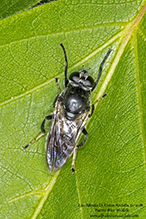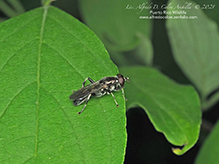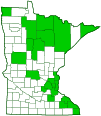leafwalkers and forest flies
(Xylota spp.)
Overview • Description • Distribution • Taxonomy
Description |
Xylota are long, slender, black, wasp-mimics. Most have a black abdomen with yellowish-orange or dark shiny spots, some have no spots, and some have an almost entirely orange abdomen. The area below a small plate on the side of the thorax (meron) and in front of the base of the third pair of legs (metacoxa) is called the metasternum. The metasternum has very short hairs. The margin of the small plate between the abdomen and thorax (scutellum) has both an upper and a lower fringe of hairs. On the hind legs, the third leg segment (femur) is enlarged. On the wings, the R4+5 vein is nearly straight. |
Distribution |
||
|
Sources Telford, Horace S.. (1939). The Syrphidae of Minnesota. University of Minnesota. Minnesota Agricultural Experiment Station. |
|
| 1/24/2025 | ||
Taxonomy |
|
Order |
|
Suborder |
Brachycera |
Infraorder |
Cyclorrhapha |
Zoosection |
Aschiza |
Family |
Syrphidae (Hover Flies) |
Subfamily |
Eristalinae (Drone Flies and Allies) |
Tribe |
Milesiini |
Subtribe |
Xylotina |
Subordinate Taxa |
|
Subgenus Ameroxylota Subgenus Hovaxylota Subgenus Sterphoides Subgenus Xylota Subgenus Xylotomima |
|
Synonyms |
|
Eumeros Heliophilus Micraptoma |
|
Common Names |
|
leafwalkers and forest flies |
|
Glossary
Femur
On insects and arachnids, the third, largest, most robust segment of the leg, coming immediately before the tibia. On humans, the thigh bone.
Scutellum
The exoskeletal plate covering the rearward (posterior) part of the middle segment of the thorax in some insects. In Coleoptera, Hemiptera, and Homoptera, the dorsal, often triangular plate behind the pronotum and between the bases of the front wings. In Diptera, the exoskeletal plate between the abdomen and the thorax.
Visitor Photos |
||
Share your photo of this insect. |
||
This button not working for you? |
||
Alfredo Colon |
||
 |
 |
|
MinnesotaSeasons.com Photos |
||
|
||
|

Visitor Videos |
||
Share your video of this insect. |
||
This button not working for you? |
||
|
Other Videos |
||
Xylota Flower-fly Licks Leaf of Giant Knotweed |
About
Nov 5, 2020 A female of lazuline flower-fly (Xylota sp., family Syrphidae) licking all over the leaf surface of giant knotweed (aka Sakhalin knotweed; Reynoutria sachalinensis, family Polygonaceae) by the roadside. I was fascinated by her sweeping movement. This plant is known to have extrafloral nectaries along the stalk. But does the leaf taste sweet, too? Alternatively, the leaf might have been stained with honeydew. I'm not sure but she seemed to lick the pollen fallen from flowers. Another hypothesis is that the fly was feeding on the Powdery mildew (probably caused by a phytopathogenic fungus; Erysiphe polygoni, family Erysiphaceae) on the giant leaves. The super-macro shot was shown at 5x slow-motion (@2:36-). Captured in the sunny afternoon (around 14:50 PM) of early-August 2020 in Japan. |
Xylota Flower-fly Grooms Herself between Meals |
About
Nov 10, 2020 Between meals, the female of lazuline flower-fly (Xylota sp., family Syrphidae) stopped to groom herself on a large leaf of giant knotweed (aka Sakhalin knotweed; Reynoutria sachalinensis, family Polygonaceae) by the roadside. Captured in the sunny midafternoon (around 15:00 PM) of early-August 2020 in Japan. |

Created: 2/23/2019 Last Updated: © MinnesotaSeasons.com. All rights reserved. |





